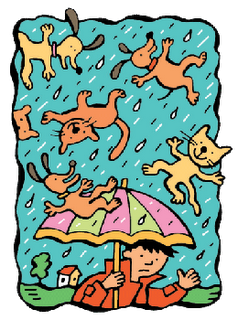e-Learning Ecologies MOOC’s Updates
You Know What I Mean?--Multimodal knowledge representations
One of the reasons that metaphors and idioms are so effective in writing is
that they use common associations to make meanings. They are figurative instead of literal and so they can use these additional connections to enhance understanding. Some of these meanings are universal, but it’s also true that many idioms can be more culturally or context specific. There’s not a lot of need to talk about how it’s raining cats and dogs, when it’s sunny outside.
During a graduate course last year, a classmate said that he felt like he was “stuck on a hamster wheel” with a research project on which he was working. Most of the class sighed in sympathy. However my friend who grew up in Jordan, and spoke English as a second language, tapped me on the arm and asked what “hamster wheel” meant. I tried to explain (I found myself referring to mice and rats, small furry animals, and merry-go-rounds), but nothing explained it effectively. Finally, I found a youtube video of a hamster on a wheel and showed it to him. Mohammad laughed so hard, we had to explain to the whole class what we found so funny.
As an English major, I actually enjoy using a variety of words and phrasing to recreate the same meaning. I can even use different genres (poems, prose, non-fiction, songs) to create written artifacts with similar audiences, purposes, and meanings. But even I am incredibly excited by how digital technology has exploded our ability to create multimodal knowledge representations. It allows us to understand each other so much better.
One simple way to think about this is to consider a “cat.” How did the word “cat” sound in your ear as you read it (How to Pronounce cat - (Audio) | Learner's Dictionary)? What is the first image that came to mind when you read the word cat? Did you think about how a cat might sound when it meows? Did you think about your pet or a cartoon cat?
I recently took a course to volunteer to teach English as a Second Language. The course provided a good deal of information about andragogy (adult learning theory) and one concept that stuck with me was Stephen Krashen’s theory of “comprehensible input.” Multimodal learning means that we don’t have to rely on words alone when we want to grow our own understanding or help others to understand us. It means that we can use as many strategies as we can think of to create meaning. In other words, the sky’s the limit.



